PROBLEMS ON ADJACENT ANGLES OF A PARALLELOGRAM
If ABCD is a parallelogram, we know that the opposite sides are parallel.
- Let us take AB ∥ DC in which AD and B will become the transversals.
- When two parallel lines are cut by a transversal, the co interior angles on the same side of the transversal are supplementary.
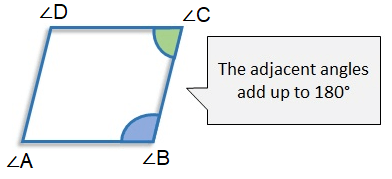
In this case,
- ∠A + ∠D = 180° and ∠B + ∠C = 180°
- ∠A + ∠B = 180° and ∠D + ∠C = 180°
Problem 1 :
If two adjacent angles of a parallelogram are (5x - 5)˚ and (10x + 35)˚, then the ratio of these angles is
a) 1: 3 b) 2: 3 c) 1: 4 d) 1: 2
Solution :
Adjacent angles add upto 180 degree.
(5x - 5)˚ + (10x + 35)˚ = 180˚
5x - 5 + 10x + 35 = 180˚
15x + 30 = 180˚
15x = 180 - 30
15x = 150
x = 10˚
(5x - 5)˚ = 5(10) - 5 = 45˚
(10x + 35)˚ = 10(10) + 35 = 135˚
Ratio = (5x - 5)˚: (10x + 35)˚
= 45: 135
= 1: 3
So, option (a) is correct.
Problem 2 :
The adjacent angles of a parallelogram are (2x - 4)˚ and (3x - 1)˚. Find the measures of all angles of the parallelogram.
Solution :
The adjacent angles of a parallelogram are supplementary.
(2x - 4)˚ + (3x - 1)˚ = 180˚
2x - 4 + 3x - 1 = 180˚
5x - 5 = 180˚
5x = 185˚
x = 185/5
x = 37˚
Thus, the adjacent angles are,
(2x - 4)˚ = 2(37) - 4 = 74 - 4 = 70˚
(3x - 1)˚ = 3(37) - 1 = 111 - 1 = 110˚
Hence, the angles are 70˚, 110˚, 70˚, 110˚.
Problem 3 :
In parallelogram ABCD, find ∠B, ∠C and ∠D.
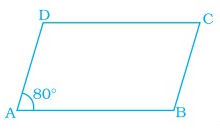
Solution :
We know that, opposite angles are equal in parallelogram.
So, ∠C = ∠A = 80˚
∠B = ∠D
∠A + ∠B = 180˚
80˚ + ∠B = 180˚
∠B = 180˚ - 80˚
∠B = 100˚
Hence, ∠B, ∠C and ∠D are 100˚, 80˚ and 100˚ respectively.
Problem 4 :
ABCD is a parallelogram. Find the value of x, y and z.
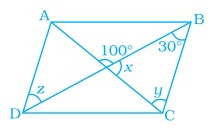
Solution :
z = 30˚ (Alternate interior angle)
100˚ + x = 180˚
x = 180˚ - 100˚
x = 80˚
In ∆OBC
80˚ + 30˚ + y = 180˚
110˚ + y = 180˚
y = 180˚ - 110˚
y = 70˚
So, x = 80˚, y = 70˚ and z = 30˚.
Problem 5 :
In parallelogram FIST, find ∠SFT, ∠OST and ∠STO.
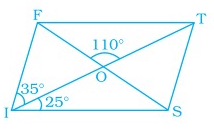
Solution :
Given, ∠FOT = 110˚, ∠OIS = 25˚ and ∠FIO = 35˚
∠OTS = ∠FIO = 35˚ (alternate interior angles are equal)
∠FOT = ∠IOS = 110˚ (vertically opposite angles are equal)
In ∆OSI,
∠OSI + ∠IOS + ∠OIS = 180˚ (sum of angles in a triangle is 180˚)
∠OSI + ∠110˚ + 25˚ = 180˚
∠OSI + 135˚ = 180˚
∠OSI = 180˚ - 135˚
∠OSI = 45˚
∠OSI = ∠SFT = 45˚ (alternate interior angles are equal)
∠FOT + ∠TOS = 180˚
110˚ + ∠TOS = 180˚
∠TOS = 180˚ - 110˚
∠TOS = 70˚
In ∆OST,
∠OTS + ∠TOS + ∠OST = 180˚
35˚ + 70˚ + ∠OST = 180˚
∠OST = 180˚ - 105˚
∠OST = 75˚
Hence, ∠OST = 75˚, ∠SFT = 45˚ and ∠OTS = 35˚
Problem 6 :
Find the values of x and y in the following parallelogram
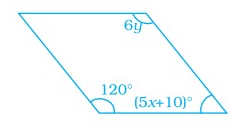
Solution :
In parallelogram opposite angles are equal.˚
6y = 120˚
y = 120/6
y = 20˚
In a parallelogram sum of corresponding angles is 180˚.
(5x + 10)˚ + 120˚ = 180˚
5x + 130˚ = 180˚
5x = 180˚ - 130˚
5x = 50˚
x = 10˚
Hence, x and y values are 10 and 20.
Recent Articles
-
Finding Range of Values Inequality Problems
May 21, 24 08:51 PM
Finding Range of Values Inequality Problems -
Solving Two Step Inequality Word Problems
May 21, 24 08:51 AM
Solving Two Step Inequality Word Problems -
Exponential Function Context and Data Modeling
May 20, 24 10:45 PM
Exponential Function Context and Data Modeling